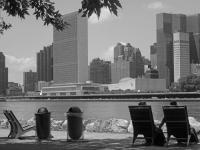Modelia Brut Kagurazaka
Shinjuku, Tokyo, Japan
This building is located in a residential area in the heart of Tokyo amid a mixture of old temples and modern houses. Kagurazaka slope, the area’s main market street, is known for its centuries-long cultural history. Roji, narrow alleys with a lot of hidden charm, branch from the main street. We attempted to determine what design of collective housing would fit into the area’s rich context.
The gently stepped approach to the building is full of nuances that remind us of how the symbolic slope looked in the old days. The approach is finished with Japanese roof tiles and the walls are lined with board formed concrete. At night, the alley is filled with tranquil lights filtering through square wooden frames within the wall.
The facade, finished with fine exposed concrete, is given characteristic shade using square openings. The openings are recessed slightly from the surface and are bordered with wooden textures. The arrangement of the opening is shifted slightly to avoid direct views while taking light, air and the view. With this arrangement of openings, we also attempted to reduce the massive wight of the concrete.
The interior shows a vivid but exquisitely simple contrast of materials. Walls are either plain white or finished with exposed concrete. There are also walnut accents: base boards made from offcuts from walnut furniture, shoe boxes have a chic texture and kitchens feature a balanced contrast of walnut and stainless steel. Each room’s space takes on unexpectedly diverse shapes with different atmospheres reflecting the town’s intricate depth. The interiors were consciously designed to stimulate the residents’ ideas for living. For example, open storage spaces can also be used as compact dens.
By this minimalistic design of collective housing with materials and space at play, we suggest a life not reliant on products, and wealth without possession. Minimalism is in direct connection with the way of living.
- Architects
- Ryuichi Sasaki Architecture
- Location
- Shinjuku, Tokyo, Japan
- Year
- 2018
- Client
- Nobumitsu Ohashi/Shukou Kensetsu
- Team
- Ryuichi Sasaki, Gen Sakaguchi, Anna Kwapien, Yuriko Ogura
- COLLABORATE ARCHITECT
- RIEKO OKUMURA/YTRO DESIGN INSTITUTE
- PRODUCER
- HIDETAKA GONAI/MODELIA CO.LTD.,
- FURNITURE
- KOJI YOKOI/KARIMOKU
- CLIENT
- NOBUMITSU OHASHI/SHUKOU KENSETSU CO.,LTD.
- CONTRACTOR
- NAKAMURAYA KOMUTEN KK












